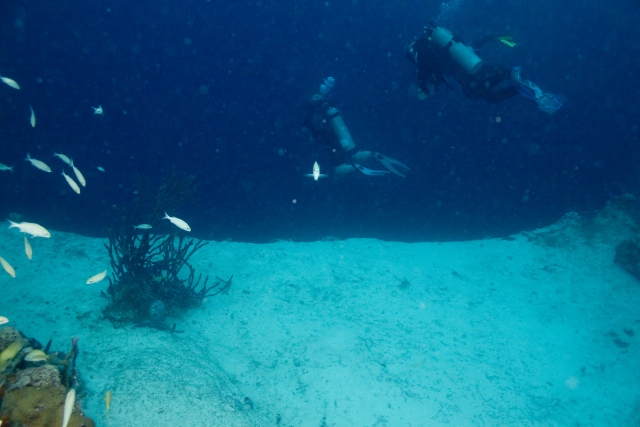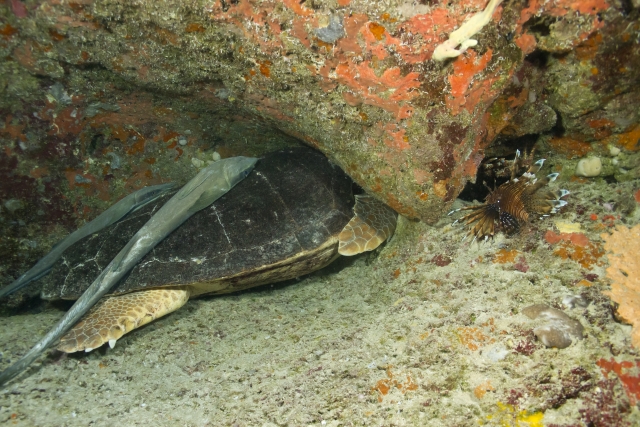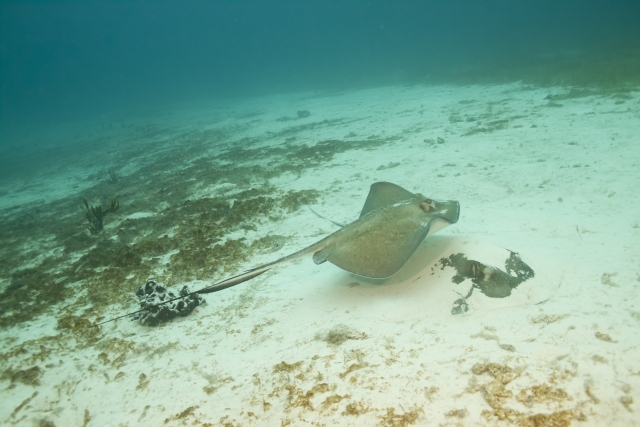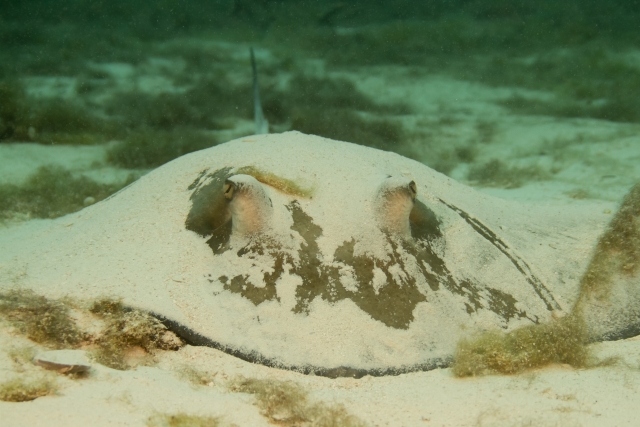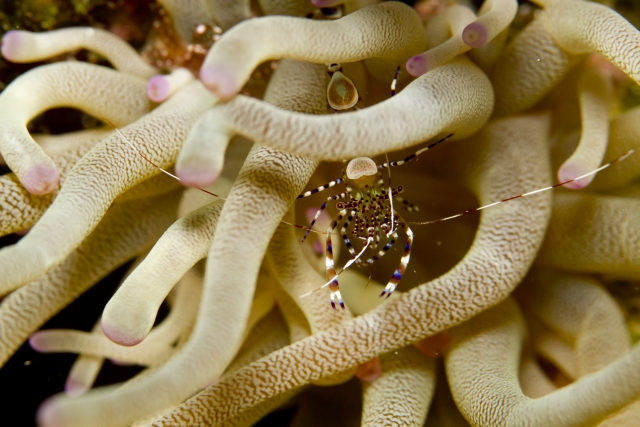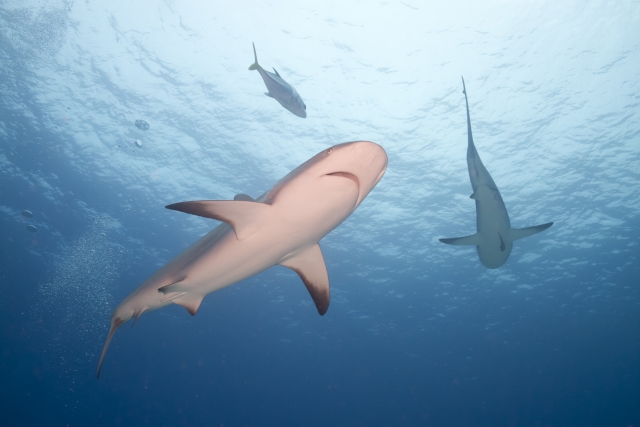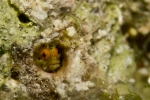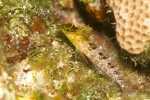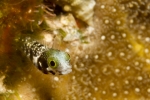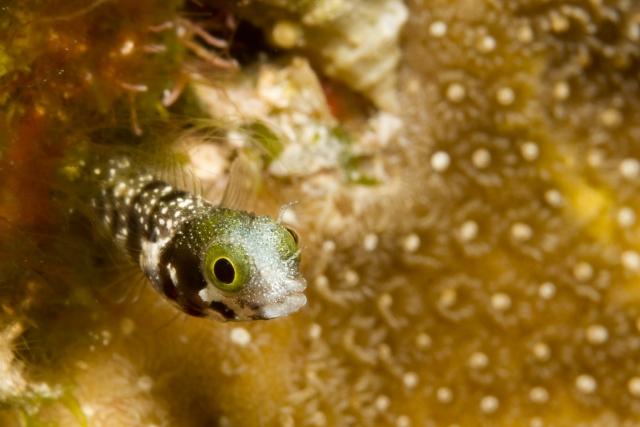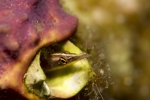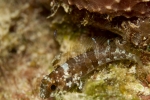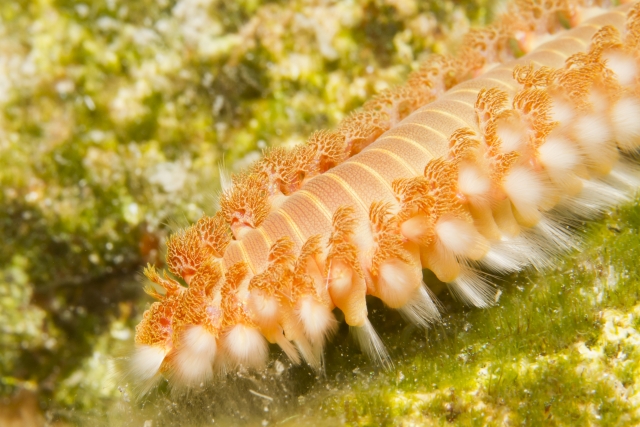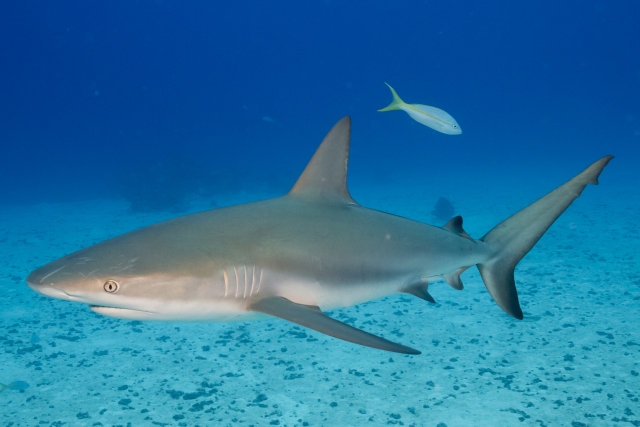underwater
Aqua Cat: Lost Blue Hole & The Invisible Stingray
ktuli — Wed, 02/04/2015 - 19:32
There you go - if that post title doesn't work for a band name or some murder mystery novel, I don't know what would... ;)
Anyway, our second to last dive on our most recent trip was at a site called "The Lost Blue Hole". A blue hole is basically an underwater sinkhole, and is so named because from above they appear a deep dark blue color when compared to the shallow light blue color of the reef and sand around them.
This photo really doesn't do justice to this blue hole, but does kind of give the idea of what it is like to dive into one - to some extent, it felt like diving off a cliff.
Technical Data: Canon EOS 7D, Canon EF-S 18-55mm f/3.5-5.6 II at 18mm. 1/200 sec at f/5.6. ISO 800. Ikelite Housing and Port with Ikelite 161 Strobe in eTTL mode. Raw conversion in Adobe Camera Raw.
Even at its widest zoom, my 18-55mm lens couldn't even begin to capture what the opening of this blue hole looked like.
As we went down into the hole, there were many ledges and shelves where various fish and other critters were taking up residence. On one large shelf, there was an enormous sea turtle with two incredibly large remoras attached to it...
Technical Data: Canon EOS 7D, Canon EF-S 18-55mm f/3.5-5.6 II at 18mm. 1/200 sec at f/5.6. ISO 800. Ikelite Housing and Port with Ikelite 161 Strobe in eTTL mode. Raw conversion in Adobe Camera Raw.
There were also plenty of lionfish at this dive site (notice the big one in the right side of the frame).
Since the day was pretty overcast, it was fairly dark down in the blue hole, so Anya and I didn't linger for long. After a few minutes, we went back to the opening to explore the sand and small patch reefs surrounding the blue hole. As we came up, Anya pointed out a medium sized Southern Stingray swimming by us. I quickly framed my shot and rattled off some photos as I gently swam along next to it.
Technical Data: Canon EOS 7D, Canon EF-S 18-55mm f/3.5-5.6 II at 18mm. 1/200 sec at f/5.6. ISO 800. Ikelite Housing and Port with Ikelite 161 Strobe in eTTL mode. Raw conversion in Adobe Camera Raw.
Look closely and see if you can spot the second, much larger stingray hiding right in front of your eyes! I honestly didn't see it the first time by, and I'm glad I wasn't swimming directly over top of it as that could have spooked it and could have been a bad situation.
We also saw a small group of Nurse Sharks, some of which were displaying flashing behavior where they give a quick tail flick while turning and rubbing their sides against the ground or some other rough surface - usually to try and rid themselves of parasites, or just to scratch an itch.
Technical Data: Canon EOS 7D, Canon EF-S 18-55mm f/3.5-5.6 II at 18mm. 1/200 sec at f/8. ISO 800. Ikelite Housing and Port with Ikelite 161 Strobe in eTTL mode. Raw conversion in Adobe Camera Raw.
By this time, I did notice the extra large stingray still hiding itself in the sand. I approached it slowly from the front and managed to get a nice portrait...
Technical Data: Canon EOS 7D, Canon EF-S 18-55mm f/3.5-5.6 II at 18mm. 1/200 sec at f/8. ISO 800. Ikelite Housing and Port with Ikelite 161 Strobe in eTTL mode. Raw conversion and cropped in Adobe Camera Raw.
While the conditions weren't great for photography because of the overcast morning, this was still an interesting dive, and a good reminder to keep my eyes open and look for hidden critters everywhere!
- Bill
Aqua Cat: More Spotted Cleaner Shrimp
ktuli — Thu, 01/29/2015 - 19:45
Here's a couple more angles of that Spotted Cleaner Shrimp...
Technical Data: Canon EOS 7D, Canon EF 100mm f/2.8L Macro IS USM, 1/200th sec at f/8. Image Stabilization on. ISO 400. Ikelite Housing and Port and Ikelite 161 Strobe in TTL Mode. Raw conversion in Photoshop CS5.
Technical Data: Canon EOS 7D, Canon EF 100mm f/2.8L Macro IS USM, 1/200th sec at f/8. Image Stabilization on. ISO 400. Ikelite Housing and Port and Ikelite 161 Strobe in TTL Mode. Raw conversion in Photoshop CS5.
Technical Data: Canon EOS 7D, Canon EF 100mm f/2.8L Macro IS USM, 1/200th sec at f/8. Image Stabilization on. ISO 400. Ikelite Housing and Port and Ikelite 161 Strobe in TTL Mode. Raw conversion in Photoshop CS5.
Have a nice weekend!
- Bill
Pederson's Shrimp
ktuli — Tue, 01/27/2015 - 18:55
Not as flash as the Spotted Cleaner Shrimp, but much more common, Pederson's Shrimp are always a fun find and a challenging photo subject. Their skinny bodies and long antennae make them difficult to get in focus. However, if you can get a bold one and hold your hand still in front of them, they will sometimes hop on your hand and pick off any dead skin around your fingernails.
Technical Data: Canon EOS 7D, Canon EF 100mm f/2.8L Macro IS USM, 1/200th sec at f/8. Image Stabilization on. ISO 400. Ikelite Housing and Port and Ikelite 161 Strobe in TTL Mode. Raw conversion in Photoshop CS5.
- Bill
Poll: Aqua Cat: Spotted Cleaner Shrimp
ktuli — Sun, 01/25/2015 - 21:19
Alright! I have finally made it through all the photos from my (at this point, not so) recent dive trip. I really should have finished them a long while ago, since the last dive certainly had a couple gems in them - in particular in the form of an encounter with a Spotted Cleaner Shrimp (Periclimenes yucatanicus). It was definitely a challenging subject due to the continually undulating anemone that it was hiding in, but I did manage several really sharp photos, and this particular one worked pretty well in several different crops... take a look and then cast your vote for which one you like best.
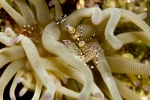 Original |
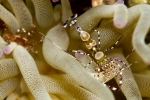 2:3 Crop |
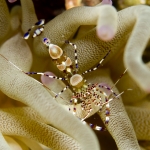 Square Crop |
|
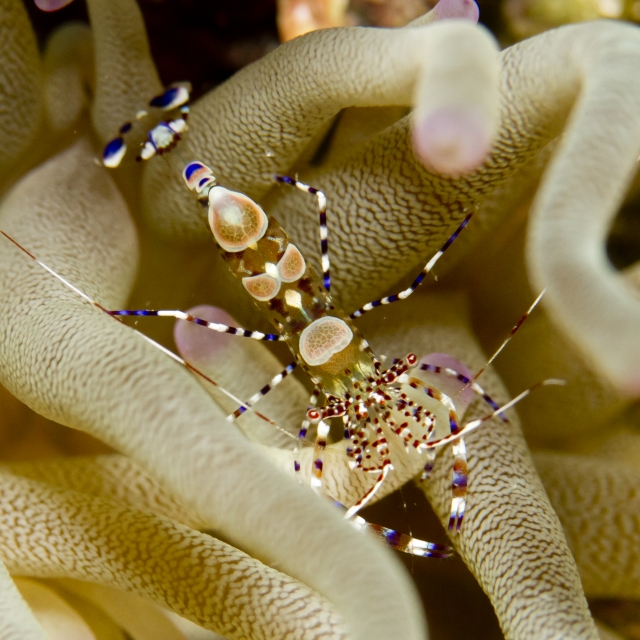
| |||
Technical Data: Canon EOS 7D, Canon EF 100mm f/2.8L Macro IS USM, 1/200th sec at f/8. Image Stabilization on. ISO 400. Ikelite Housing and Port and Ikelite 161 Strobe in TTL Mode. Raw conversion and cropped in Photoshop CS5.
Honestly, I didn't even notice the crab also hiding in the anemone at the time - I was so focused on capturing a species of shrimp that I'd never seen before.
There are still a handful more good shots from the trip, so hopefully I'll post a little more frequently to get them shared here. Stay tuned.
- Bill
Aqua Cat: Circling Reef Sharks
ktuli — Wed, 01/07/2015 - 15:45
It is ridiculously cold here, so I'm daydreaming about warm waters and circling reef sharks...
Technical Data: Canon EOS 7D, Canon EF-S 18-55mm f/3.5-5.6 II at 22mm. 1/250 sec at f/8. ISO 400. Ikelite Housing and Port with Ikelite 161 Strobe in eTTL mode. Raw conversion in Adobe Camera Raw.
Stay warm wherever you are...
- Bill
Aqua Cat: Batch of Blennies
ktuli — Mon, 12/29/2014 - 20:45
Blennies are small reef fish that can often go unnoticed due to their often shy nature and cryptic camouflage. Here's a nice set of blenny portraits...
I've shared other posts with blennies in the past, and it seems that they are a favored photo subject for me.
A fun story with the pikeblenny... Anya found this little guy during our shark feeding dive on our last trip. While the rest of us were completely engrossed in the twenty-or-so sharks ranging in size up to about eight feet long, Anya was interacting with this little fellow on the sandy ocean floor. I managed to get a few shots with the wide-angle lens, but focusing was a bit of a challenge. If you look closely, that feisty little guy is coming up out of its hole to bite Anya's finger. It also took a few nips at me as well - so we can say with complete honesty that we've sustained multiple bites during a shark feed dive!
- Bill
Aqua Cat: Bearded Fireworm
ktuli — Mon, 12/22/2014 - 19:10
Ok - I've been lazy/busy (take your pick) and haven't been posting often, but here's a cool shot of a Bearded Fireworm (Hermodice carunculata) taken on our recent dive trip. We didn't see too many of these until the last day or so of diving, then they seemed to be everywhere. This one in particular really appears to be on fire and definitely illustrates one of the sources of its name - the other is from the fact that those white bristles you see can inject a painful toxin that causes a burning sensation. Definitely not something you should mess with!
Technical Data: Canon EOS 7D, Canon EF 100mm f/2.8L Macro IS USM, 1/250th sec at f/16. Image Stabilization on. ISO 400. Ikelite Housing and Port and Ikelite 161 Strobe in TTL Mode. Raw conversion and cropped in Photoshop CS5.
Thanks for stopping by.
- Bill
Aqua Cat: Bloodworms are Photobombing Jerks!
ktuli — Tue, 12/09/2014 - 10:10
So we've talked about feeding bloodworms to reef critters on multiple occasions, and I've briefly touched on how annoying they can be... but today I will show just what photobombing jerks they really are...
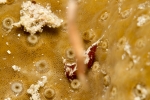 |
 |
 |
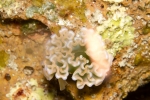 |
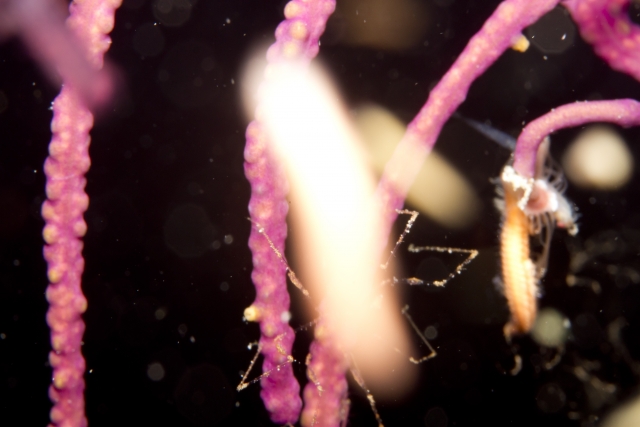 |
|||
The night dives in the Bahamas were especially bad with bloodworms, and this is just a small sampling of the photos ruined by these prolific little annoyances (most of the rest just got deleted).
- Bill
Aqua Cat: Caribbean Sea Spider
ktuli — Mon, 12/01/2014 - 21:07
Yep - you read that right - Caribbean Sea Spider (Andoplodactylus sp). I'm sure to some folks, it comes as no surprise that I managed to find spiders underwater too...
Ok - it isn't a true spider, but it is somewhat related. Both spiders and sea spiders are in the subphylum (the classification above class) Chelicerata. I've been fascinated with them ever since I first saw them listed in my identification, and so when I spotted one during a night dive, I instantly knew what I was seeing. I unfortunately did not come back with the best photos, but I'll explain that a bit more later.
 |
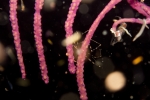 |
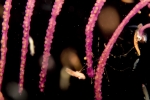 |
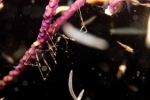 |
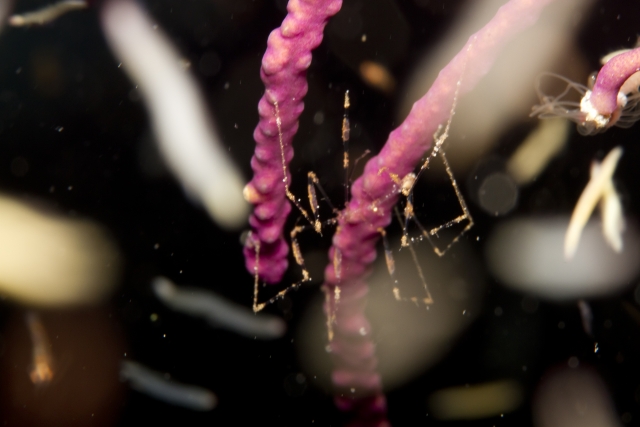 |
|||
Technical Data: Canon EOS 7D, Canon EF 100mm f/2.8L Macro IS USM, 1/250th sec at f/16. Image Stabilization on. ISO 400. Ikelite Housing and Port and Ikelite 161 Strobe in TTL Mode. Raw conversion in Photoshop CS5.
I know - I'm sure for most folks those photos look like a while lot of nothing - if you can even figure out what you're looking for at all. In general, the sea spider just looks like a jumble of legs to be honest, but like I said - I knew instantly what I was looking at and was thrilled with my find. I only spent about three minutes photographing it, and the conditions were absolutely horrible (I'll explain more on that tomorrow) and so I will have to continue searching for another one to get a decent photo.
But for now, I get to show everyone that there are spiders in the ocean too... :)
- Bill
Aqua Cat: Another Reef Shark
ktuli — Mon, 11/24/2014 - 19:58
Sorry - it has been a while since I have posted... I got sick last week and then have been working on a bunch of little projects around the house - I haven't even found time to process any more photos. So just stopping by real quick to share another Caribbean Reef Shark photo today.
Technical Data: Canon EOS 7D, Canon EF-S 18-55mm f/3.5-5.6 II at 22mm. 1/200 sec at f/5.6. ISO 400. Ikelite Housing and Port with Ikelite 161 Strobe in eTTL mode. Raw conversion in Adobe Camera Raw.
- Bill

